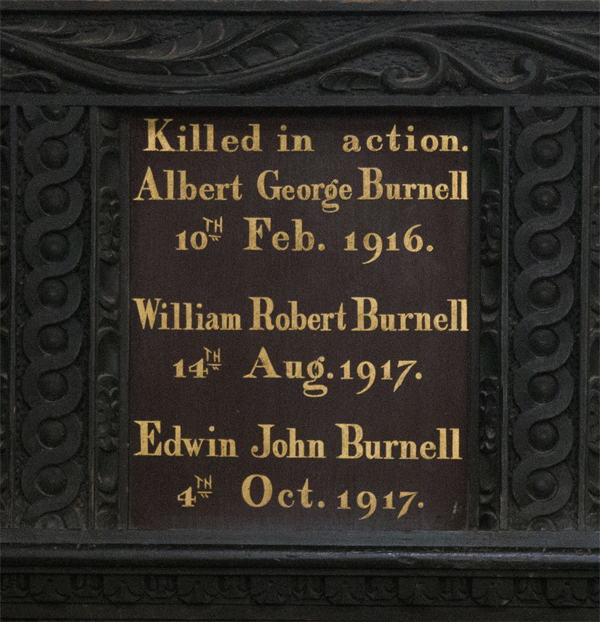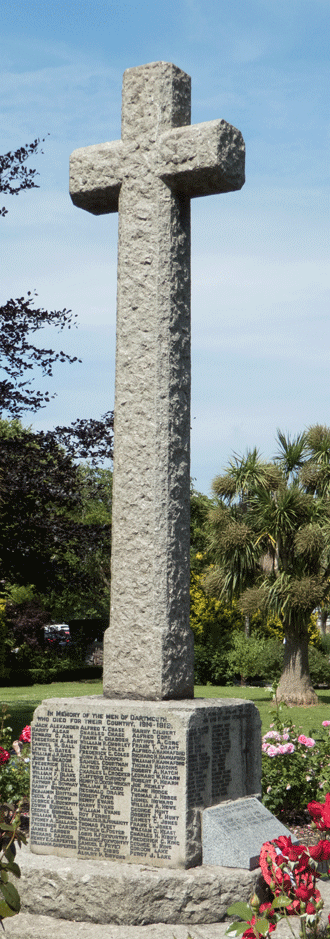William Robert Burnell
Family
William Robert Burnell was not a native of Dartmouth but was born in Schull, County Cork, in Ireland, in 1883, where his father, William Burnell, was serving with the Coastguard Service. For the story of William Burnell (senior), and his wife, Mary Ann May, see the story of Albert George Burnell, William Robert's younger brother, already published.
The Burnell family had returned to Devon from Ireland by the time of the 1901 Census, when William (senior) was Chief Boatman at the Coastguard Station in Salcombe. By this time William Robert was aged eighteen, and working as a bus conductor.
By 1911, William (senior) had retired from the Coastguards and moved to Dartmouth. However, it seems unlikely that William (junior) ever lived in Dartmouth, for he moved to London before his father's retirement. In 1906, William married Nellie Mary Ann Gibbs in West Ham, Essex. Nellie was a younger daughter of Henry Gibbs and his wife Mary Ann, and was a little older than William, having been born in 1874, in Hackney. Henry Gibbs had come to London from Wiltshire. At the time of the 1881 Census, when Nellie was seven, he was a brewer's drayman. Nellie had worked in domestic service but in the 1901 Census, she was living with her parents and younger brother Albert, and working as a dressmaker.
The 1911 Census recorded William and Nellie living at 91 Seymour Road, Leyton. William was a stock keeper in a tin factory. At that time the couple had no children; their only son, Eric Bertram, was born on 18th April the following year.
Service
Unfortunately William's Army service records have not survived. Soldiers Died in the Great War states that William enlisted in Leyton, where he lived. It further records that he was first posted to the King's Royal Rifle Corps, with the service number R/27896. A comparison of this number with similar numbers of other men whose service papers have survived, suggests that he may have attested under the Derby scheme late in 1915, and been mobilised some months later in 1916. An estimate of the likely date he joined may be inferred from the war gratuity paid to Nellie after his death, as recorded in the Soldiers Effects Registers. This indicates that his service began in May 1916.
At the time of his death William was serving with the 10th Battalion of the Rifle Brigade and was a Lance Corporal. As yet no records have come to light to show when he transferred from the King's Royal Rifle Corps to the Rifle Brigade. However, during the period William is likely to have served, there is only one reference in the War Diary of the 10th Battalion to reinforcements arriving. This is in September 1916, when 149 other ranks arrived on 28th September and 302 the following day, so this may well be when William joined the Rifle Brigade in France.
The 10th (Service) Battalion of the Rifle Brigade was one of several Kitchener battalions of the Regiment. It was formed in September 1914 and went with 59th Brigade in 20th (Light) Division to France in July 1915.
At the time the reinforcements arrived, the Battalion was on the Somme, " ... occupying dugouts at the foot of the Northern slope of the Carnoy Valley". The War Diary makes clear that the main focus of the Battalion's activities for the next few weeks and months was to provide these new drafts with the training they needed, and that to begin with, they found the conditions difficult.
The day after they arrived, they were inspected by the Brigadier at Brigade Headquarters, after which their "training was pushed on". On 3rd October they received orders to move to a new camp near Trones Wood, and the following day to relieve 61st Brigade in the front line. To get there "the distance was long and the condition of the ground very bad, and it was found hard to get the men of new drafts along" - some tracks were "knee-deep in mud". The 10th Battalion took over the support line: "the trench was found to be a quiet one, though much shelling went on all around". What was (presumably) William's first stint in the trenches lasted only three days before they were relieved and marched to billets in Méaulte on 8th October, and Méricourt on 9th October.
As they moved further back behind the front, the training of the new drafts continued. By 21st October, after a series of moves, they had reached "good billets" in the village of Breilly, on the Somme river north-west of Amiens. The War Diary records the training regime:
Full advantage was taken of the excellent facilities available for training, but work was rather impeded by bad weather. The daily programme included half an hours physical drill, running etc before breakfast, three hours parades in the morning and two hours in the afternoon. From 6.0pm to 9.0pm each evening one Company was engaged in night operations, and each day one Company used the Range and had its wiring parties trained by an attached RE Sapper. The usual classes for Lewis Gunners, Bombers and Signallers continued and made good progress. During leisure, teams to represent the Battalion in the approaching Divisional Sports were trained, and each day 16 All Ranks were allowed passes to Amiens.
In November they moved to Saisseval, not far away, to worse billets but "excellent facilities for training, of which full advantage was taken". A Rifle range was established and a bayonet fighting course was laid out. Nearby at Ailly-sur-Somme there were practice trenches and this enabled the new drafts to get some practice of trench relief in the dark, and to practice an attack.
On 15th November they left Saisseval for Méricourt, because they were expected to be going into the line again, but plans changed and on 28th November they arrived at Mansel Camp for "a tour of work on the roads in the forward area". The billets once again were not good: "three huts for officers and tents without floorboards for the men. A spell of cold weather added to the discomfort".
They continued with their work on the roads for several days and then went into the trenches "south-east of LesBoeufs" (the southern sector of the Somme front). Apparently their practice reliefs had been helpful, for there were no casualties during this real relief. However:
The tour that ensued was one of the most trying ever experienced. The trenches occupied were still only battle trenches, and were constantly falling in and everywhere full of mud and water. It rained almost continuously and on the night of the 11th [December] there was a heavy fall of snow. Casualties were few, but the number of sick was very large. In view of these conditions, the Battalion was taken out after a tour of two days, instead of three as had been fixed originally.
Indeed, many men were in such a bad way that it took them many hours to reach the camp at Guillemont; and for the next stage of their journey Camp XVIII, Carnoy West, "the men were in a condition of extreme exhaustion, and most of them were carried on conveyances of all kinds picked up on the roads".
However, during the next tour in the trenches, from 15th - 17th December, "conditions were still very bad, but on the whole the Battalion suffered less severely". On the other hand, the support trenches were shelled, and two men were killed, with 20 wounded.
The Battalion did a further tour in the same place from 21st-23rd - and this time, although the trenches were still bad, "the weather [was]better, and there were no casualties at all".
By Christmas Day 1916 they were in "fairly comfortable" billets well to the rear in Corbie, though delayed for several hours by a broken down train. The War Diary makes no mention of Christmas festivities, but they had two days off before resuming a regime of parades, training, and afternoon football.
During January 1917, they did several short spells in the trenches "round and south of Sailly Saillesel", billeted in-between near Combles. The weather was "very cold with front and snow ... and this made work [to improve trenches] more difficult".
By February 10th, they had moved to trenches in front of LesBoeufs, "facing north in the direction of Le Transloy, billeted in between at Carnoy, until the middle of February, when they were moved "into a deep dugout large enough to hold 300 men". On 19th February, when back in the trenches, the centre Company "holding an extremely advanced post, was rushed from three sides by a much superior force of the enemy at 5.30pm. This attack was accompanied by liquid fire ... the post, being completely surrounded and outnumbered, was lost".
One officer and eight men were killed, seventeen men were wounded, but one officer and 47 men were missing, all but one from "D" Company.
Their next few tours were less eventful until the middle of March, when the War Diary gives an account of the Battalion's experience of the German withdrawal to the Hindenburg Line:
By this time [14th March] a general German retirement had begun in front of the Army on our left and all information available pointed to a similar retirement from our front. Accordingly the Battalion pushed patrols out to its front continuously each night ... On 15th the Guards Division on our right was able to get a footing in the enemy line to the south of Sallisel and on the 16th the 12th Rifle Brigade two Battalions to our right captured a small post in the enemy front line. There was no change in front of us, and the Battalions to our left and on our immediate right also found the situation normal and the enemy line strongly held. On the night of the 16th aeroplane information received by Brigade pointed to the fact that a German retirement on a large scale was about to begin. No transport anywhere near the German lines had been visible. Trees had been cut down and laid across the main roads and moreover though the aeroplane had been flying very low no anti-aircraft fire had been directed upon it.
The Battalion therefore sent out special patrols during the night but the response was such that they concluded it was "certain that at 5am the enemy was still holding his front line". However, when Brigade HQ heard that the 14th Australian Brigade had got into the enemy front line, the 10th Battalion was ordered to sent out a patrol even though it was after dawn. When 2nd Lt White bravely walked over to the enemy front line in broad daylight at 7am, he "was rewarded by finding it empty and by being the first officer or man of the 59th Brigade to enter the enemy trenches".
The Battalion therefore pushed forward as far as possible before being relieved. When they returned to the front a few days later they suddenly found themselves in a mobile battle. On 28th March they were in the village of Etricourt and on 30th March were involved in a successful attack on the German outpost positions of Neuville-Bourjonval and Dessart Wood, though two officers and 32 men were wounded (one of the officers was the brave 2nd Lt White, who sadly died of his wounds two days later).
On 4th April, they were in front of Metz en Couture, attacked that day by 59th Brigade. The 10th Battalion was in reserve, but one company was attached to the 11th Rifle Brigade and another to 11th King's Royal Rifle Corps, who led the attack; the other two 10th Rifle Brigade companies were sent up later as reinforcements. The village was captured by 6pm and they were relieved the following day. Casualties during the attack and the preceding day (when one company had been involved in a reconnaissance patrol) were one officer died of wounds and four men killed, with one officer and fifteen men wounded.
The Battalion was not involved in the Arras offensive, remaining in the southern sector during May. They held the front line at Havrincourt Wood, near Metz, between 3rd-13th May and 17th- 21st May. By 24th May, they had moved a little north, to hold the front line at Lagnicourt. On 28th May, they went into Divisional Reserve for a period of training, pitching camp near the village of Vaulx-Vraucourt. This seems to have provided a welcome break:
The whole of this rest was conspicuous for the most delightful weather. Sports, probably the most enjoyable the Battalion has had for a long period, were carried on every evening and sometimes in the afternoon as well. The final of the inter-company football championship was won by "C" Company, the winning goal being gained in the last five minutes. A new feature in the sports was Graeco-Roman wrestling, introduced by Rfn Golisky, a Russian serving with the Battalion.
All too soon, on 9th June, they were in the front line east of Bullecourt, where the Battalion War Diary records, with some frankness:
A strong smell was a constant reminder of the recent heavy fighting ... the Battalion was lucky to get out of the front line before the retaliation, provoked by a raid of the 58th Division north-west of Bullecourt, had begun.
They completed two tours in the trenches near Bullecourt before going by train to Berneuil, north of Amiens, for an extended period of training and sports, including a Brigade sports day in which the Battalion won the first prize in four events. The training now underway was part of the preparation for the forthcoming Flanders Offensive, and on 20th July, by way of a ten-hour train journey, they arrived at camp a mile south-east of Proven, near Poperinghe, for:
... a period of rest. The Battalion was organised ... for the approaching operations ... 8 officers and 108 other ranks were detailed to be left out of the battle ....50 at the Corps Reinforcement Depot at Bollezeele, the remainder staying at the transport lines.
Though the War Diary does not mention it, the immense bombardment carried out prior to the attack had begun four days earlier, and would have been clearly audible and visible from where they were.
Their rest was interrupted when they were ordered to relieve the 13th Royal Welsh Fusiliers, who were taken out of the front line for a few days, as they were due to participate in the first day of the attack on 31st July. The 10th Rifle Brigade thus took over the front line on "West Canal Bank", north of Ypres, from 26th - 29th July, during the build-up to the attack. Four men were killed, and 31 wounded, one of whom died. One officer was also wounded. The War Diary also recorded the Battalion's first encounter with mustard gas, which caused burns and temporary blindness. Fortunately, their protection was effective:
During this tour the Battalion for the first time experienced the new German gas shells. These fortunately did not cause any casualties, as all ranks had been warned. The danger arose from the fact that it is possible to be in the gas for several hours without feeling anything but slight effects. During the night of 29th this gas was quite thick, but the box respirator afforded sufficient protection.
The Royal Welsh Fusiliers duly returned and the 10th Rifle Brigade spent the next few days in a "wood near Canada Farm". They were not required for the attack, nor immediately after it. (For an account of the first day of the Battle of Third Ypres, see the stories of Richard Henry Goodman Carder, who was part of 51st Division, attacking north of Ypres, and William John Farrow Bates, part of 8th Division, attacking east of the city.) Instead they sent working parties to "make tracks on the Canal Bank and across the [Yser] Canal", whilst "C" Company was sent to make main and advanced Divisional Ammunition Dumps.
Meanwhile the 20th (Light) Division relieved the 38th Division, on the right sector of the XIV Corps front, to the north of Ypres. The aim was to follow up the assault of the first day, and capture the village of Langemarck, beyond the River Steenbeek. But four days of extremely heavy and continuous rain had prevented the attack going in sooner; and though there had been a short interval of fine weather, on 11th August the rain had started again. The 10th Rifle Brigade moved forward to the support line, in the pitch dark and pouring rain, while being heavily shelled; and on 12th August, further forward still, into the front line on the west bank of the Steenbeek.
A preparatory attack was planned on 14th August, to cross the Steenbeek and occupy the ground immediately beyond it, so as to secure the ground necessary for the attack on Langemarck itself. On 13th August, there was a heavy artillery bombardment of the positions to be attacked, which was observed to achieve several direct hits on "pill-boxes".
For the attack, two companies of the 11th Rifle Brigade were attached to the 10th; the remaining two companies of the 11th were in reserve. According to the War Diary, the six companies were in line, from left to right, "A", "D", "B", and "C" Companies of the 10th Rifle Brigade, with the two 11th RB Companies on the right (the Rifle Brigade history puts the companies the other way round).
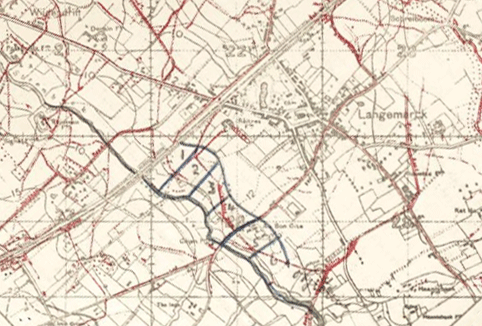
The attack on the Steenbeek
By 3.0am on 14th August the six companies were formed up along a tape 250 yards west of and parallel to the Steenbeek, each on a two-platoon front, with the two platoons behind planned to "mop up" as the attack went forward.
The War Diary records that as they assembled:
... the enemy sent over a large number of gas shells ... At 4.0am (Zero hour) the attack commenced, and a well-directed barrage was laid down on the east bank of the Steenbeek. The enemy immediately opened out with fairly heavy machine gun fire; his barrage was not excessive. Considerable difficulty was experienced in crossing the Steenbeek as the bridges carried up by the assaulting troops were found to be too short in some places, and the men had to ford the stream, the bed of which was extremely muddy. Casualties from shell and machine gun fire were unfortunately heavy, especially those of our right company ("C" Company) who were met by intense machine gun fire from Au Bon Gite on the right flank and also frontal fire. However the line pushed forward and established itself about 250 yards on the east side of the river. Gallant efforts were made to force the strongly fortified blockhouse Au Bon Gite, which had not been damaged by our shell fire to any degree. Our right flank in conjunction with the left Company 11th Rifle Brigade made several determined attacks on the block-house, but the Germans, as soon as attack was imminent, closed a strong iron door, and all efforts to dislodge them were useless.
Our left companies were slightly better off, and had less difficulty in reaching the objective, although they suffered considerably from sniping and machine gun fire. By 6.0am consolidation was in progress. Unfortunately by this time all the Company Commanders had become casualties, and "B" and "C" Companies were without any Officers at all. Reinforcements from the 11th RB were ordered to make their way up to our "A" and "D" Companies, and proceeding in driblets and with considerable difficulty succeeded in reaching them. The remainder of the day and night was spent in consolidation, which consisted chiefly in improving shell holes. Enemy sniping very severe.
A pencil addition in the typed War Diary records that "during the night enemy patrols were repulsed by our fire".
On 16th August, the main attack on Langemarck by 60th and 61st Brigades was successful, and 11th Battalion Rifle Brigade was finally able to take Au Bon Gite; thirty prisoners were taken, including six officers, and two machine guns. See the story of Reginald Pritchard Bawden killed in this action.
Death
10th Rifle Brigade's War Diary records that casualties were heavy "during the tour", recording a total of:
On 18th August, the Battalion having been relieved and returned to camp at Proven, near Poperinghe, several memos were sent to GHQ, 3rd Echelon, recording casualties. From these, daily casualty lists were drawn up and sent to the Rifle Records in Winchester; unusually, the lists remain in the War Diary.
A list of 23rd August 1917 lists ten of those killed on 14th August, including "S/26215 L/C Burnell W R".
News of William’s death reached Dartmouth quickly. The following announcement appeared in the Dartmouth Chronicle of 31st August 1917:
Deaths
Burnell - Killed in action, August 14th 1917, in France, Cpl William Burnell (Rifle Brigade), beloved eldest son of Mr and Mrs W Burnell, Post Office, Dartmouth, aged 34 years.
The newspaper also included an account of the circumstances in which William had died, from letters sent to Nellie:
Died in Succouring his Commanding Officer
An extremely sad story, but withal one of the most brilliant in connection with the war, is furnished with the news to hand of the heroic death of Corporal W Burnell, of the 10th Rifle Brigade, eldest son of Mr and Mrs Burnell, of the Dartmouth Post Office. His widow, Mrs Burnell, who resides in London, received the news of her husband’s death in the following letter from the Rev H Bowman, Church of England Chaplain:
“Dear Mrs Burnell
I very much regret to inform you that your husband, W Burnell, of the 10th Rifle Brigade, was instantaneously killed on the 14th. Please accept my deepest sympathy. These are sad and trying days for us all. May God comfort and console you in your great grief. Your husband was a stretcher bearer. We know that we are but separated from our loved ones for a time. Some day, somewhere, we shall meet them again. It is this certainty which gives us courage to carry on in these dark times.”
From another letter which Mrs Burnell has received there is every reason to believe that Corpl Burnell met his death in a gallant attempt to succour his commanding officer, who had been wounded. It is stated that the corporal was going out to him and was killed on the way.
We are quite sure that the sincere sympathy of every resident in Dartmouth will go out to Mr and Mrs Burnell. This is the second son they have lost in the war, their next eldest one, Private George Burnell, having been killed on February 10th 1916. Their youngest son, Eddie, is a lance-corporal serving with the Devons at the front.
William’s name appeared in the Essex Roll of Honour published in the Essex Roll of Honour published in the Essex Newsman on 22nd September 1917, and in the weekly casualty list of 25th September 1917.
Commemoration
Though William was known to have been killed in action on 14th August, he has no known grave, and is thus commemorated on the Menin Gate at Ypres.
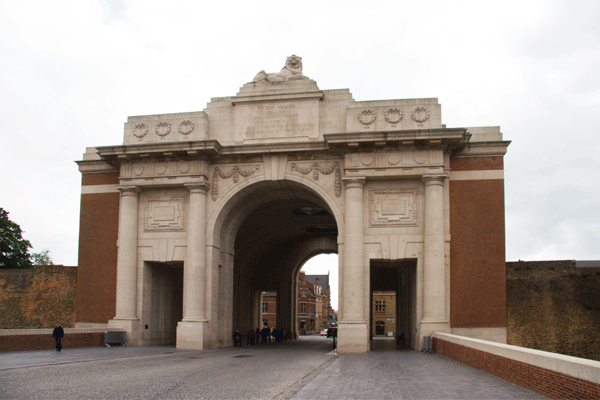
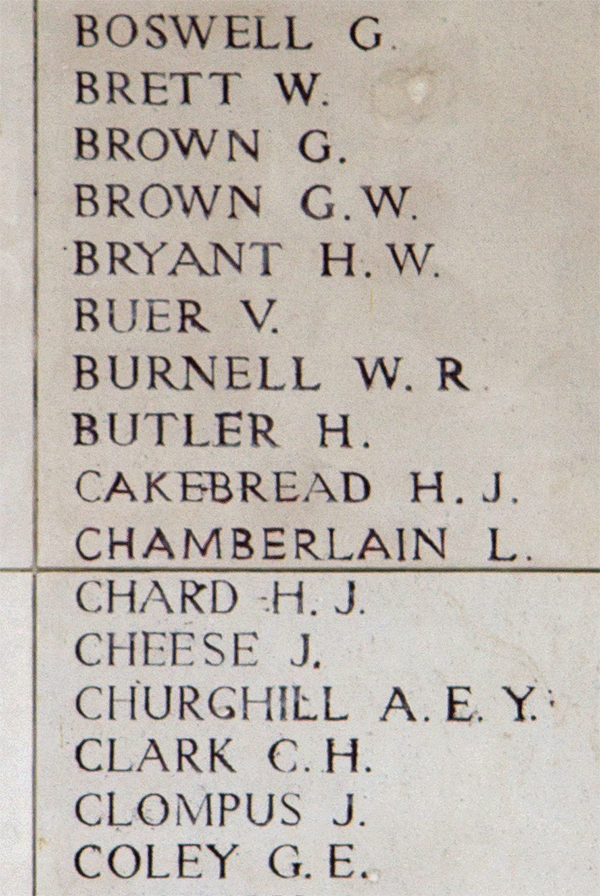
In Dartmouth, he is commemorated with his brothers George (already referred to) and Edwin (whose story will be published later this year), on the Town War Memorial, the St Saviour's War Memorial Board, and on a panel on the St Petrox Memorial.

















